How to do the Mountain Gorilla trekking in Uganda
July 4, 2022
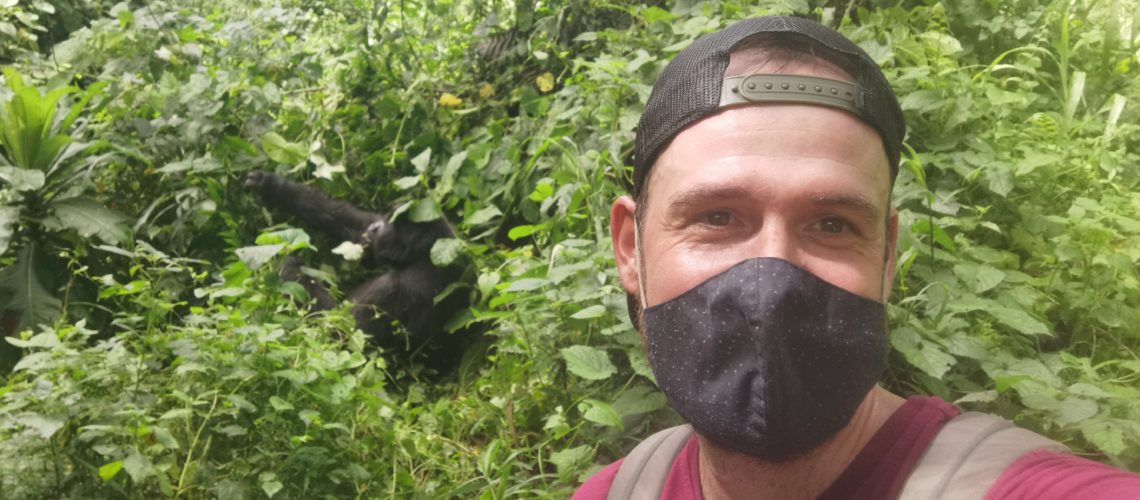
Finally, after 2 hours of early morning walking, we find a group of gorillas. We walk up to a gorilla who is plucking off a few leaves to eat. As I stand about 5m in front of the gorilla, he stands up and beats his chest with his hands and then runs in the opposite direction, a little further into the jungle. My guide tells me that he has just greeted me. From there, the actual trek starts while I accompany the endangered mountain gorillas and follow them deeper into the jungle…
Why should you see mountain gorillas?
There are only 1063 mountain gorillas left in the world in 2022. The gorillas now live only in the rainforests of Rwanda, DR Congo and Uganda. Mountain gorillas are uncannily similar to humans and share 98% of DNA. They live in the mountains at altitudes of up to 4000m. They are up to 1.75m tall and can weigh around 200kg. Mountain gorillas live in groups, usually with one male and an average group size of 9-10 gorillas. However, it can also happen that several males belong to one group and the groups are larger. Then one male has the more dominant role. During mountain gorilla trekking, you not only seek out the animals, but you also accompany them on their wanderings through the mountains. Seeing the animals in the wild is an incredibly impressive experience, which I describe below.
What is a silverback?
The characteristic of adult male gorillas, besides their impressive size, is the silverback. The silverback means that the male’s back is white. Here, short white hairs cover the back of the male gorilla. This is not necessarily a sign of particularly old age, but the white hairs develop when the males are fully grown. A silverback is therefore an adult male mountain gorilla, usually from the age of 12.
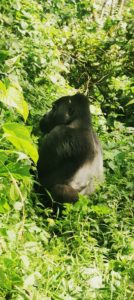
Where can I see mountain gorillas and how much does it cost?
Mountain gorillas can be seen in Rwanda, DR Congo and Uganda. The countries differ primarily in their prices. You don’t have to book a tour but can buy the ticket directly from the rangers via the links provided. The tour itself is similar and I describe it below.
The costs for the individual countries are:
Rwanda: 1200 USD
In Rwanda there is only the possibility to see the gorillas in the north at the border to Uganda in the Volcanos National Park. In 2021, the fee for a gorilla permit was still 1500 USD. In 2022, the price was reduced to 1200 USD. The gorillas in Volcanos National Park can also be visited from the other side of Uganda. The national park there is called Mgahinga Gorilla National Park.
Uganda: 700 USD
Uganda is a very popular place to visit the gorillas. Uganda, like Rwanda, is a rather safe country and robberies and armed confrontations are rather rare and not comparable to DR Congo in terms of frequency. Uganda has two great national parks to see gorillas. In the south, on the border with Rwanda, is the Mgahinga Gorilla Park. This one has the reputation that trekking is rather easier and you have a better view of the gorillas, as the forests are not as densely overgrown as in Bwindi National Park. However, it can happen that all the gorillas are on the Rwanda side and in that case you are not lucky enough to see a gorilla.
A little more centrally located is Bwindi National Park. It is a large park with 4 entrances and is home to about 400 mountain gorillas. Due to its size and dense forestation, the national park is recommended for fit people with hiking experience. During the hike, you will cover several metres in altitude as well as kilometres to visit the gorillas in their daily work.
Gorilla trekking can be booked through the UWA (Uganda Wildlife Authority) here.
DR Congo: 400 USD
A popular destination is the Virunga National Park. Unfortunately, there are currently ongoing armed conflicts between the Congolese army and the M23 in the border region with Uganda and Rwanda and the park is not open regularly. During my visit in 2022, it was unfortunately not possible to visit the gorillas there. For the latest information on whether the park is open and to book tickets, click here.
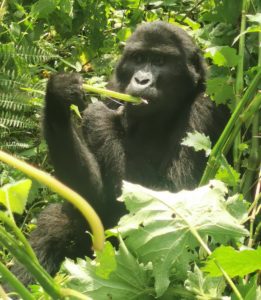
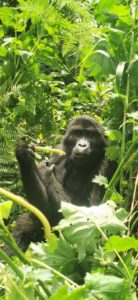
Can I see the gorillas spontaneously or do I have to book in advance?
Before Covid, you had to book up to 3 months in advance to see the mountain gorillas. Since the start of Covid, there have been hardly any visitors and therefore you could still buy a ticket the day before through the official channels without any problems (as of May 2022). You can book via the websites described above or on site. Transport can also be arranged on site. Alternatively, you can buy a tour package for which you have to pay a little more in addition to the gorilla permit, but you don’t have to organise the journey yourself. Since it is easy to organise the journey yourself, I will explain below where you can stay overnight in the vicinity and how you can plan your journey.
Where should I stay if I want to see the gorillas in Uganda?
If you have enough budget, you can stay on site at Mgahinga National Park or Bwindi National Park. If you want to save a little money, you can stay in the town of Kisoro from 6 USD a night. Kisoro is centrally located and the journey to Mgahinga National Park takes about 45 minutes (by mototaxi or taxi). The cost of a mototaxi here is about USD 7 return. The journey to Bwindi National Park takes about 1.5 hours by mototaxi or taxi. The cost of a mototaxi to Bwindi is about 15 USD return.
What do you do on the gorilla trek?
The trek starts at 8 am in the morning. Accordingly, you should plan to be on site by 07:45 at the latest. It is important to be at the right entrance gate. There are 4 different gates in Bwindi, so when buying your Gorilla Permit make sure that you buy it for the correct gate. If you buy the ticket locally from the Uganda Wildlife Authority, they will also be happy to help you organise a suitable driver for Bwindi or Mgahinga.
The gorillas are observed by the rangers every day until the evening hours to make sure that no poacher kills them and to know approximately where the last gorilla group stayed the next morning. Therefore, the rangers go to the last observation point at 7 am in the morning to look for the gorillas and to guide the guides with the tourists to the right place.
At the beginning, you are divided into groups with the other visitors. A group consists of up to 8 people. Since Covid began, it is also possible to be alone in a group with the guides. After a short briefing, the guides are in constant contact with the rangers and wait for a positive signal and directions as soon as they have spotted the gorillas. As soon as this is done via walkie-talkie, the visitors can be led to the gorillas. Depending on how far the gorillas have moved during the night, this can mean a few hours of walking through the rainforest to the gorillas.
Once the guides have led you to the gorillas, you have one hour to accompany the gorillas and take photos or videos. The gorillas are peaceful and are used to having people around with a little distance, as they are visited on an almost daily basis. Here you follow the gorillas further into the rainforest and mainly see them feeding in the rainforest. It is an amazing experience to see these animals so close and in the wild. The rangers are armed in case of emergency. However, the rifles are not used to protect against an attack by gorillas, as they are generally peaceful. Since wild elephants also roam the rainforests, they serve as a scare gun to drive away aggressive wild elephants, as they pose a higher danger to the visitors. After an hour with the gorillas, you make your way back to the starting point. Depending on how far you have followed the gorillas and how far you are already in the rainforest, the mountainous way back can take another 2-3 hours, so that you need a total of up to 4-8 hours for the excursion, depending on the range of the gorillas. In any case, it is an incredibly impressive experience. And if you don’t have the energy for the way back because of the long hike, you can still treat yourself with an African helicopter.
Here you can see a video of my adventure during the trek:
What is the African helicopter?
An African helicopter could be one of those beautiful helicopters that rescues climbers who have had an accident. Close, but not quite! So the whole thing is not quite so far-fetched, because the assistance is there for people who have struggled through the mountains and have run out of strength and need help to get back to civilisation. The only difference is that an African helicopter in Uganda is not a real flying helicopter. Instead the guide calls a few helpers who come with a stretcher and then carry you back to civilisation for about 300 USD over several hours (depending on the distance).
Is it worth it to see mountain gorillas?
For me personally it was an amazing experience and I didn’t expect to be so close to the mountain gorillas on the one hand, and on the other hand that they would welcome you so peacefully into their circle. In the meantime, I almost ate a little with the gorillas myself, because I already felt completely at home in the circle. It is impressive how big and muscular the gorillas are and yet how you lose your fear after just a few seconds because they give such a relaxed impression. The hour with the gorillas was intense and simply wonderful to see the animals so close. Thumbs up!
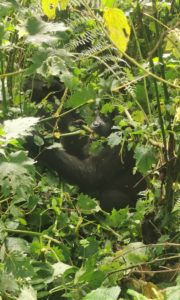
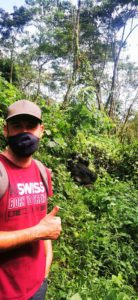
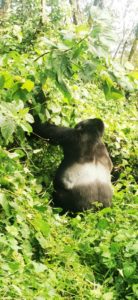
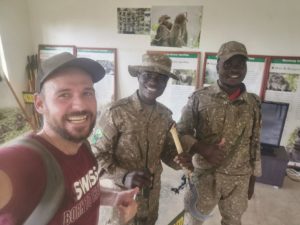








[…] in their natural territory. You can find more about the gorilla trekking in the separate article here. The park also offers other activities such as bird watching, nature walks, and cultural […]
Er ist zurück! Schön zu sehen, dass Dein Notebook wiederhergestellt ist und Berichtreihe weitergeht !
Yessss :), jetzt werden mehr Afrikaartikel folgen